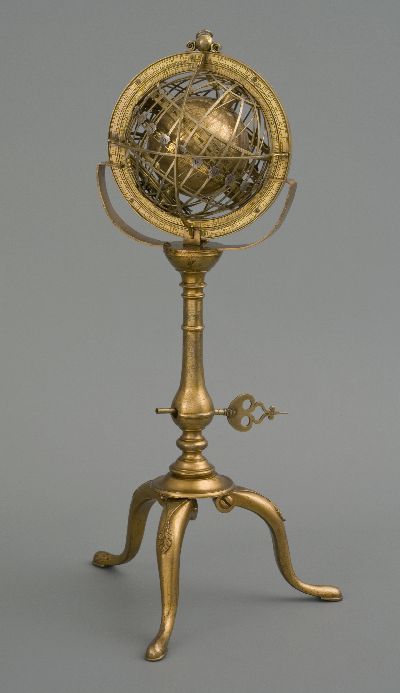
an extraordinary object from the collection of the Jagiellonian University Museum with a fascinating history
„The Golden Jagiellonian Globe”, ca. 1510
While visiting the Museum let’s stop by for a moment in the treasury to have a look at one of the oldest globes of Earth. The object dating back to the 16th century is in fact a mechanical armillary sphere inside of which a globe was installed, also equipped with a clock mechanism driving the entire device.
It is one of the earliest armillary spheres, executed in France in the beginning of the 16th century. The globe however, or precisely its map, was made later, around 1510. Most probably the map was done by a cartographer from Florence, Francesco Rosselli (1448 – before 1513).
The map corresponds with the cartographic knowledge of the time (the beginning of the 16th century). However, an unsual continent appeared on the southern hemisphere, situated South, South-East from Indochina. „The Island continent” - how it is sometimes called – at first glance may look like Australia, but at this time the land was yet to be discovered. The continent is to represent America, furthermore – the North one [sic!] apparently, because South America is depicted on the southern hemisphere, near its actual location - as its longitude is a bit inaccurate… At this time the method for exact calculation of longitude (and thus for designating position during sea travels) was not known. What is more, the continent is described as „America Noviter Reperta” which means – „Newly discovered America”! It is the first globe on which the name „America” has appeared!
Interesting comparison can be made between our object and similarly dated Globe of Hunt-Lenox from the New York Public Library, which can be seen here https://dslab.lib.rochester.edu/hunt-lenox-globe/.
Maps on both globes are similar but were made by two different cartographers. Other thing, though, is that both cartographers relied on the same source – the maps of Martin Waldseemüller (1470-1520) and letters of Americo Vespucchi (1451-1512), that were published in Ptolemy’s Cosmographiae introductio… (Johannes Schöner, Saint Dié, 1507).
In the 18th century small changes in the device’s construction were introduced but it did not interfere with the mechanism of the sphere’s operation. The object can still be succesfully used, of course instead of searching for a location according to the continents’ position, one should refer to geographical coordinates. The map became outdated soon after it was created as the early 16th century was the Age of Discovery. At the time remarkable corrections were added to the world map every 10 to 15 years.
The Globe was bequeathed to the University of Krakow by professor Jan Brożek (1585-1652) who in turn purchased it in Italy.
The object still has some mysteries and curiosities. Newest paper about the Golden Globe is to be published in 2020. More about the object – as an astronomical instrument and universal clock was presented by Marcin Banaś i dr Małgorzata Taborska during a conference Coronelli Society (Zurich 2019). The paper The Jagiellonian Globe as a mechanical armillary sphere – history, construction, operation is to be published in the latest edition of the journal Der Globusfreund (in English)
Also, history of the object is presented in an article by Małgorzata Taborska published in the Jagiellonian University magazine Alma Mater, which is available here https://issuu.com/alma-mater/docs/alma_mater_217/114.
Issues related to the Globe’s map and regarding the objects construction details will be reveiled in the article The Golden Jagiellonian Globe from the Jagiellonan University Museum collections – unusual object with a fascinating history (in Polish) in the latest edition of the journal Opuscula Musealia (in print).
More details on the object’s history during the wartime is to be found in a paper by Jadwiga Schoen, with comments of Anna Środoń and Marcin Banaś: https://issuu.com/alma-mater/docs/alma_mater__179/48 as well as in a paper by Barbara Ryś https://issuu.com/alma-mater/docs/alma_mater_136/96.
